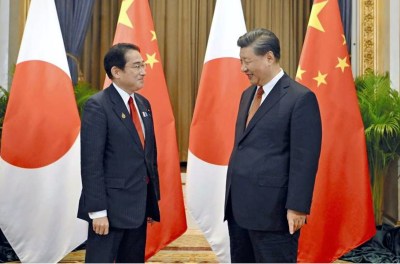The Yoshida Doctrine is no longer fit to understand Japan’s grand strategy.
Its precepts emerged under former prime minister Shigeru Yoshida as an interim grand strategy in the aftermath of Japan’s defeat in the Second World War and were designed to help to realize the country’s economic recovery and redevelopment.
The Yoshida Doctrine prescribed that Japan maintain two principles. First, the continuation of a US military presence to guarantee Japan’s national security. Second, that it would eschew a resource-consuming and politically destabilizing military build-up.
To implement the latter principle, Japan gradually established a number of policy self-restraints, such as a defense budget ceiling of 1% of GDP and the choice not to acquire long-range missiles and nuclear weapons.
The Yoshida Doctrine’s original economic purpose was achieved by the 1970s, though Tokyo retained it for a number reasons, including assuaging its regional neighbors’ worries about its potential as a military menace as it became the region’s largest economic power.
The continuation of the Yoshida Doctrine was far from easy. Many Japanese leaders had serious discomfort about its foundations — including the useful, yet constraining, security treaty with Washington which legally sanctioned a US military presence in Japanese territory.
While some Japanese policymakers did imagine Japan’s future without the security treaty, Tokyo judged that the country should stick to the alliance framework. One reason was to contribute to regional stability by rendering its self-restraints more credible in the eyes of neighbors.
To complement this reassurance, Japan also exercised self-restraint in regional multilateralism by carefully avoiding any outright leadership and respecting Southeast Asian countries’ initiatives. This reassurance logic of the Yoshida Doctrine survived the end of the Cold War.
Over the last decade, some key assumptions underpinning the Yoshida Doctrine have become outdated because of Japan’s relative decline.
“Declinism” is an unstated thesis in Japanese domestic debates on its grand strategy, but its influence on the country’s strategic thinking and practices is unmistakable in two respects.
First, Japanese leaders’ imagination about their available military options has stretched as Japan’s self-restraints have eased. Tokyo’s recent decisions to acquire long-range missiles and abolish the 1% of GDP ceiling on defense spending, reversing decades-old policy positions, are examples of Japan’s changing view on the reassurance imperative.

Second, Japanese leaders’ imagination about Japan’s broader strategic options has shrunk. Unlike during Japan’s economic ascent, no members of the Japanese government are entertaining departing from the defense treaty with the United States.
Instead, they emphasize how Japan’s eroding self-restraints will bring Tokyo and Washington even closer together as military allies. A weakened Japan cannot imagine any other option but to embrace the United States, especially in dealing with China’s rising power.
Tokyo’s willingness to strengthen its military alliance with Washington further does not mean Japan simply supports US pushback against China. Despite Japan’s relative material decline, it seeks a comprehensive influence on Washington’s thinking.
Japan’s acquisition of longer-range strike capabilities, combined with the growing geopolitical importance of its location next to Taiwan, is making Tokyo an essential ally for US-China strategy. This allows Japan to seek to have a greater say in strategic discussions and coordination.
As a close ally, Tokyo has also been voicing its concerns about Washington’s democracy-versus-autocracy narrative and signaling its reservations about the US-led Indo-Pacific Economic Framework.
Tokyo’s attempt to relax self-restraints and expand its influence is not only observable in Japan-US bilateral interactions. The same trend emerged earlier in Japan’s regional economic diplomacy.
The most obvious example is the leading role played by former prime minister Shinzo Abe’s government in saving the Trans-Pacific Partnership after the US withdrawal in 2017. Abe was not constrained by regional suspicions about Japanese ambitions or a desire to avoid any regional political backlash.
As these common trends suggest, Japan’s emergent grand strategy focuses on mitigating the negative impact its diminishing material strength has on its international influence by overturning many longstanding self-restraints.
This emergent grand strategy remains nameless because the country is yet to address many crucial questions before it can be fully described, let alone conceptualized.
One of the main questions is whether Japan can use the elevated influence it anticipates to better manage its tension-prone bilateral relationship with China.
Relaxed self-restraints, a stronger US-Japan alliance and more active regional diplomacy all constitute a signal to Chinese leaders that Japan remains a formidable neighbor, despite its relative decline, and one with which even a vastly superior China must coexist.

To emphasize this “co-existence” message, Prime Minister Fumio Kishida’s government held a summit with China’s leader Xi Jinping and established a direct hotline between the two countries’ defense organizations.
Further progress on Japan’s China policy — beyond these symbolic steps — could produce a positive spillover effect on other aspects of its grand strategy.
It would make East Asian states more comfortable about partnering with Japan and give Tokyo greater confidence in steering the US alliance. The lift of Japan’s influence would also add further pressure on China to take Japan more seriously.
If Japan succeeds, its emergent grand strategy as a declining power could become more than an attempt to balance China.
As Kishida has alluded, his gaze is set not on “a converged single set of values,” but on creating a modus vivendi in Asia which would at least prevent regional disagreements from escalating into catastrophe and enable peaceful coexistence, including between Japan and China.
Whether and how Japan can cultivate this endeavor, despite its decline, will shape the nature of the country’s new grand strategy and its effect on the transition of the regional order in Asia.
Yusuke Ishihara is a Senior Fellow at The National Institute for Defense Studies, Tokyo. The views expressed in this article are the author’s own and do not represent the official positions of NIDS.
This article was originally published by East Asia Forum and is republished under a Creative Commons license.

